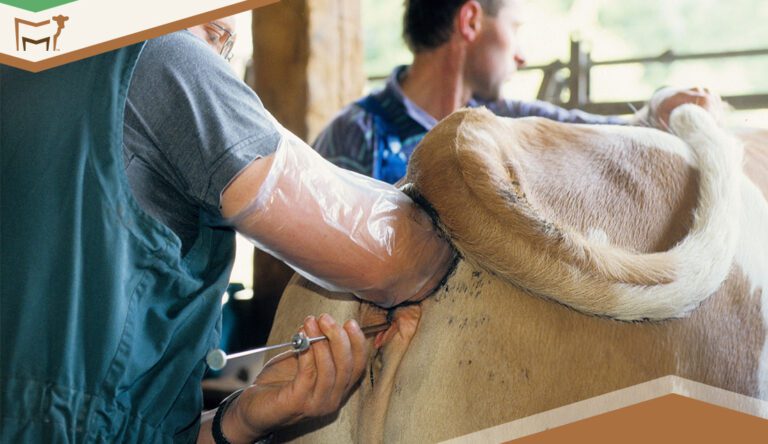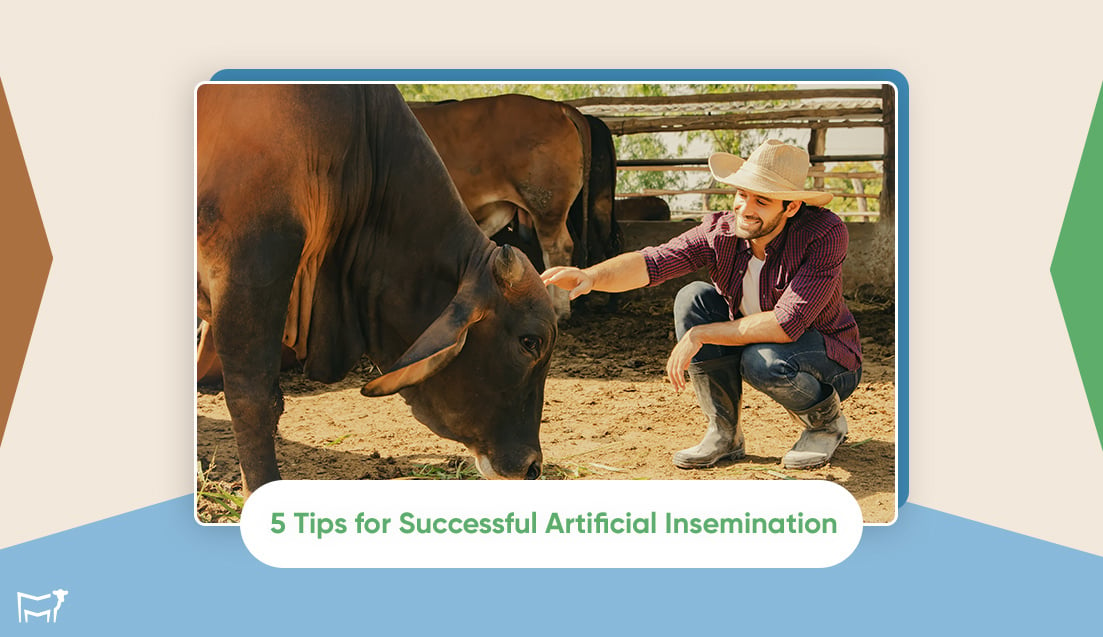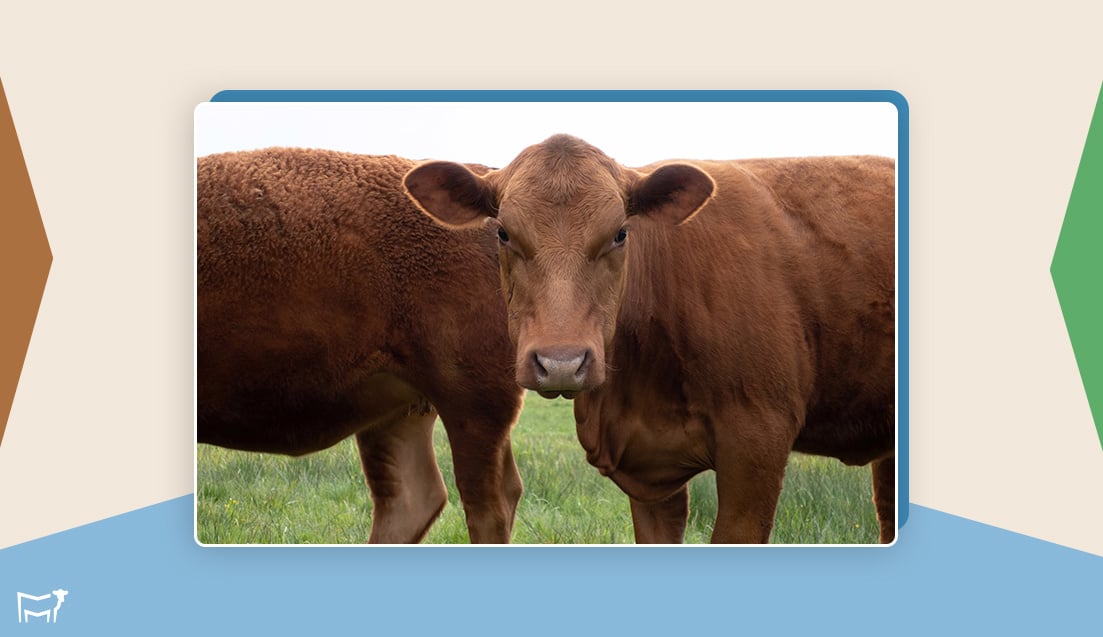A Comprehensive Guide for Ranchers about Artificial Insemination in Cattle

Artificial insemination (AI) in cattle is a breeding technique where semen from a bull is manually placed into a cow’s reproductive tract. It’s a way to get cows pregnant without using a live bull on your ranch.
During AI, a trained technician or veterinarian uses a specialized instrument called an insemination gun to deposit semen directly into the cow’s uterus. This process is done when the cow is in heat (estrus). The semen used is typically collected from bulls, then frozen and stored in thin straws until needed.
When it’s time for insemination, the semen is thawed and loaded into the insemination gun. The technician then gently guides the gun through the cow’s cervix and releases the semen into the uterus. This mimics natural breeding but doesn’t require a bull to be physically present.
Why is Artificial insemination Beneficial for Ranchers?
Access to superior genetics
Artificial insemination allows ranchers to use semen from top-quality bulls that would be too expensive or impractical to own. This means you can introduce excellent genetic traits into your herd without the cost of purchasing and maintaining elite bulls.
You can select semen from bulls with proven records for traits like growth rate, feed efficiency, milk production, or carcass quality. Over time, this can significantly improve your herd’s overall performance and value. You can easily diversify your herd’s genetics by using semen from multiple bulls, which helps prevent inbreeding and can introduce desirable traits from different breeds.
Increased safety and convenience
Keeping bulls on a ranch can be dangerous and resource-intensive. Bulls are large, powerful animals that can be aggressive and unpredictable, posing risks to ranch workers and other cattle. By using AI, you eliminate the need to house and handle live bulls, significantly reducing the risk of injuries. It’s also more convenient – you don’t need to maintain separate bull pastures or worry about bull-to-cow ratios. AI allows you to breed any number of cows without the logistical challenges of managing multiple bulls. This can be beneficial for those with limited land and resources.
Better breeding management and timing
Artificial insemination gives ranchers much more control over their breeding program. You can precisely time inseminations to align with your desired calving schedule, which can be crucial for managing labor and resources during calving season.
AI also makes it easier to synchronize heat cycles in your herd, allowing you to breed and calve in tighter windows. This can lead to more uniform calf crops, which is advantageous for marketing.
AI enables you to easily keep detailed breeding records, helping you make more informed decisions about which genetics work best in your herd over time.
Cost-effectiveness in the long run
While there are upfront costs associated with AI (equipment, training, semen purchases), it can be more economical than natural service in the long term, especially for larger operations. You avoid the ongoing expenses of purchasing, feeding, and caring for multiple bulls. AI also allows you to use semen from bulls that have been extensively tested for genetic defects and fertility, potentially reducing calf losses and improving overall herd productivity.
By improving your herd’s genetics over time, you’ll see increased returns through better performing cattle, whether that’s through higher milk production, faster growth rates, or better quality beef. This long-term genetic improvement can significantly boost your ranch’s profitability.
4-Step Process for Artificially Inseminating a Cow
Detect heat
Watch your cows closely for signs of heat (estrus). A cow in heat will often be restless, mount other cows, or stand still when mounted. She might also have a swollen vulva and clear mucus discharge.
Timing is crucial – you want to inseminate about 12 hours after you first notice these signs. Some ranchers use heat detection aids like tail paint or electronic monitors to make this job easier. Proper heat detection is key to successful AI, so take your time to learn the signs and check your cows at least twice daily during breeding season.
Prepare the semen
Get your AI supplies ready. You’ll need the frozen semen straw, AI gun, sheaths, and gloves. Thaw the semen straw in warm water (about 95°F) for 30-45 seconds. Be careful not to overheat it – this can kill the sperm.
Once thawed, dry the straw, cut the sealed end, and load it into the AI gun. Keep the loaded gun warm by tucking it in your shirt or using an insulated gun warmer. Work quickly but carefully – you want to keep the semen at body temperature and use it within 15 minutes of thawing.
Inseminate the cow
A trained AI Technician or Vet should complete this next step. It is vital that proper steps are taken, or permanent damage could be done to the cow. The steps your AI tech should take are as follows. Clean the cow’s vulva with a paper towel. Gently insert the AI gun into the vagina, angling it slightly upward to avoid the urinary opening. Use your other hand (with a gloved arm) in the rectum to guide the gun through the cervix. You’ll feel the cervix as a firm, tubular structure. Gently manipulate it to help the gun pass through. Once through the cervix, deposit the semen slowly at the entrance of the uterus. Don’t force the gun – if you meet resistance, back up and try again. After insemination, slowly withdraw the gun and gently massage the clitoris to encourage sperm transport.
Keep records
Right after inseminating, write down the cow’s ID, the date and time of insemination, and the bull’s information. Good record-keeping is crucial for tracking which cows should be pregnant, when they might calve, and how successful your AI program is. It also helps you make better breeding decisions in the future.
But using notebooks or spreadsheets is outdated and inefficient for modern ranching. A specialized tool like CattleMax can dramatically improve your record-keeping and overall herd management. You can log breeding events instantly from your smartphone, whether you’re doing individual AI or group natural service breeding. CattleMax has features like:
- Automated breeding record creation when using the “Turn in Bulls” feature
- Tracking AI technicians and semen inventory
- Pregnancy check recording and status updates
- Estimated calving date calculations
- Customizable reports on breeding success rates
It gives you a comprehensive view of your breeding program’s success. To see how it can streamline your entire breeding program and boost your ranch’s efficiency, take advantage of CattleMax’s 21-day free trial. It’s a great way to experience firsthand how modern technology can transform your record-keeping and breeding management.
5 Tips for Successful Artificial Insemination

Master your heat detection skills
Spotting a cow in heat at the right time is crucial for AI success. Learn to recognize the signs:
- A cow standing still when mounted by others
- Clear mucus discharge, and a swollen, red vulva.
Check your herd at least twice daily, especially during cooler parts of the day when cows are more active. Early morning and late evening checks can catch subtle signs you might miss midday.
When you see signs, mark down the time. Aim to inseminate about 12 hours after you first notice standing heat. This timing lines up with when the egg is released and gives you the best shot at conception. Remember, every cow is different – some show strong signs, others are subtle. The more you observe, the better you’ll get at catching those critical moments.
Handle semen with care
Proper semen handling can make or break your AI success.
When you’re ready to inseminate, start by having all your supplies ready: thaw unit, thermometer, AI gun, paper towels, and gloves. Thaw only one straw at a time in warm water (95-98°F) for about 45 seconds. Use a thermometer to check the water temperature – guessing isn’t good enough. Once thawed, dry the straw thoroughly and protect it from sunlight and rapid temperature changes. Load it into a pre-warmed AI gun, and keep the loaded gun warm by tucking it in your shirt or using an insulated gun warmer.
Work efficiently as you want to use the semen within 15 minutes of thawing for best results. Never refreeze thawed semen or try to use it later. If you’re new to this, practice loading the AI gun with some expired straws before breeding season to get comfortable with the process.
Perfect your insemination technique
Getting the semen in the right spot is key. Before you start, make sure the cow is properly restrained and calm. Clean the vulva thoroughly with a paper towel to prevent introducing bacteria. Gently insert the AI gun at a slight upward angle to avoid the urinary opening. Use your other hand (with a shoulder-length glove) in the rectum to gently manipulate the cervix and guide the AI gun through. You should feel three rings in the cervix – aim to deposit the semen just past the last ring, at the entrance of the uterus.
Don’t force it if you meet resistance; back up and try again. Deposit the semen slowly – it should take about 5 seconds.Good technique comes with practice, so don’t get discouraged if your first attempts are tricky.
Focus on cow comfort and stress reduction
Stress can significantly lower conception rates, so making AI day as calm as possible for your cows is crucial. Set up your working facilities to minimize noise and confusion. Use solid sides on your chutes to reduce visual distractions. If possible, bring cows up in small groups rather than all at once – this keeps them calmer and prevents them from standing around too long.
Handle cows gently and avoid shouting or using prods. If a cow seems overly stressed, consider letting her calm down before inseminating. Be mindful of the weather too – extreme heat or cold can affect conception rates. On hot days, provide shade and consider inseminating earlier in the morning. Have plenty of fresh water available. A calm cow is more likely to conceive, so anything you can do to reduce stress will pay off in better AI results.
Prioritize nutrition before and after breeding
What you feed your cows in the months leading up to and following AI can significantly impact your success rates. Aim to have your cows at a body condition score (BCS) of 5 to 6 on a 9-point scale at breeding time. Cows that are too thin or too fat have lower conception rates. Start adjusting nutrition about 60 days before breeding season to get cows to the right BCS. Focus on providing a balanced diet with adequate energy and protein. For example, you might need to boost energy with grains or high-quality hay if your pastures are lacking. Don’t forget about minerals – copper, zinc, and selenium are particularly important for reproduction.
After breeding, maintain good nutrition to support early embryo development. Sudden diet changes or feed restrictions in the first 30 days post-AI can lead to embryo loss. If you’re breeding heifers, pay special attention to their feed. They need to reach about 65% of their mature body weight before breeding for the best results. Consider working with a nutritionist to develop a feeding plan tailored to your herd’s needs and your available feed resources. Remember, good nutrition isn’t just about getting cows pregnant – it sets the stage for healthy calves and good milk production down the line.
Keep accurate breeding records with CattleMax

If you’re ready to take your breeding program to the next level, tools like CattleMax can provide the data management backbone needed to turn good practices into great results.
With CattleMax, you can easily track AI events, monitor breeding success rates, and generate insightful reports to guide your decision-making. The software’s user-friendly interface allows you to input data directly from the field, ensuring your records are always up-to-date.
You can try CattleMax for free for 21 days. This gives you the chance to explore all the features and see how they can streamline your breeding management without any financial commitment. To help you get started, we even offer a personal demo. This one-on-one session allows you to ask questions, see the system in action, and learn how to tailor CattleMax to your specific needs. You can book the demo here.

Jacqueline
Jacqueline, a true Wyoming native, was raised on her family's ranch just north of Cheyenne. Her journey led her to the University of Wyoming, where she earned a Bachelor of Business Administration in Management and Marketing. She and her husband, Darrell, manage a thriving herd of commercial Angus cattle.

